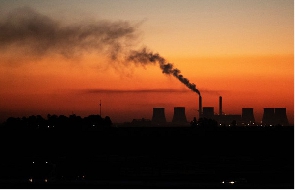 Scheduled blackouts have long burdened South Africa
Scheduled blackouts have long burdened South Africa
South Africa’s struggling state power utility Eskom has predicted a “very difficult winter” starting in June, warning that it may have to increase electricity cuts to an unprecedented level amid the country’s worst-ever power crisis.
Many households and businesses in Africa’s most industrialised economy are already facing scheduled electricity outages – or load shedding – of more than 10 hours a day, largely due to breakdowns in Eskom’s ailing fleet of coal power stations.
The gap between supply and demand is expected to increase in the coming winter months as people turn on their heaters, putting additional pressure on the grid.
“This is going to be a very difficult winter,” Eskom Group Executive for Transmission Segomoco Scheppers told a media briefing on Thursday.
Winter demand for power is expected to surge to about 33,000 megawatts but Eskom is only able to produce 26,000 megawatts.
Eskom has not yet gone beyond “Stage 6” power cuts, which require 6,000 megawatts to be shed from the national grid. This winter it may move to “Stage 8”, Scheppers said, which would require up to 8,000 megawatts to be shed, translating to 16 hours of outages in a 32-hour cycle.
“Stage 8” is just one scenario that Eskom is preparing for if its interventions are not effective, he said, explaining that the power cuts are necessary to avoid a national grid collapse.
“The alternative, which is a blackout, is really a nightmare scenario because it is an uncontrolled situation where the whole country loses supply,” said Scheppers. The likelihood of this is very low, he added.
South Africa’s power crisis has deepened over the past year, taking a heavy toll on several sectors and threatening price rises.
Analysts say underinvestment in the maintenance of ageing coal plants for years has affected Eskom’s capacity to deliver consistent power supply to millions of households. Some of the newer power plants have also broken down due to overburdening. Corruption and sabotage have also been blamed for the crisis, while Eskom has also had to deal with wage disputes and strikes by its workforce.
The crippling power cuts have had a severe effect on South Africa’s economy, reducing its gross domestic product by about 5 per cent in 2022, according to Eskom.
“The escalating electricity crisis is causing untold devastation across all social and business activities in the country,” the influential Black Business Council said earlier this year.
Separately, a government official told Reuters news agency on Thursday that South Africa will auction at least 10 new onshore blocks for shale gas exploration in the environmentally sensitive Karoo region.
South Africa’s first competitive auction for oil and gas resources, expected in 2024 or 2025 once legislation making provision for the bid round is passed, is expected to be held as the country eyes alternative energy sources to ease the power crisis.
“We are potentially looking at a minimum of about 10 shale gas blocks in the Karoo that will be released through competitive bidding,” Bongani Sayidini, chief operating officer at the Petroleum Agency of South Africa (PASA) said.
PASA estimates the Karoo Basin holds about 209 trillion cubic feet (tcf) of technically recoverable shale gas resources, although a 2017 study by geologists at the University of Johannesburg said this was probably 13 tcf, the lower end of estimates ranging between 13 tcf to 390 tcf.
Even 5 tcf would be enough for a 1,000 megawatt (MW) to 2,000 MW gas-fired power plant to supply electricity for up to 30 years, the Academy of Science of South Africa said in its Karoo shale gas action plan released last year.
It is not clear how the cost would compare with existing coal fire power stations or the ever-cheaper wind and solar energies that are gradually replacing them.
Fracking in the Karoo basin, a vast area covering more than half of South Africa’s land surface has been shelved for a decade because of resistance from environmental activists and farmers, and regulatory uncertainty.